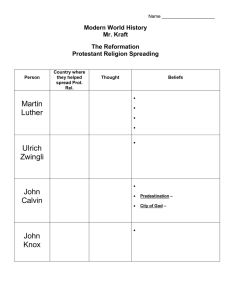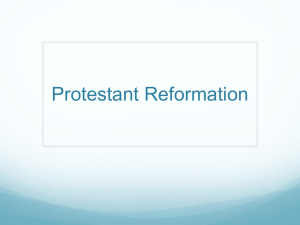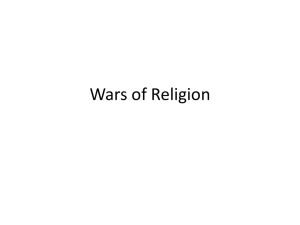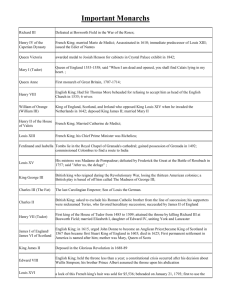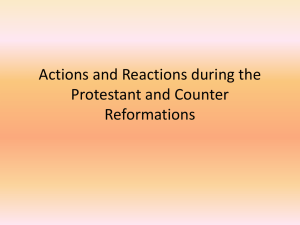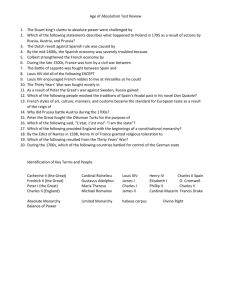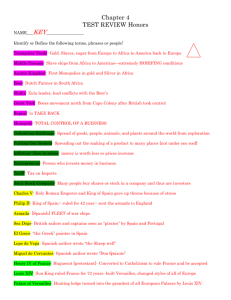Chapter 24
advertisement
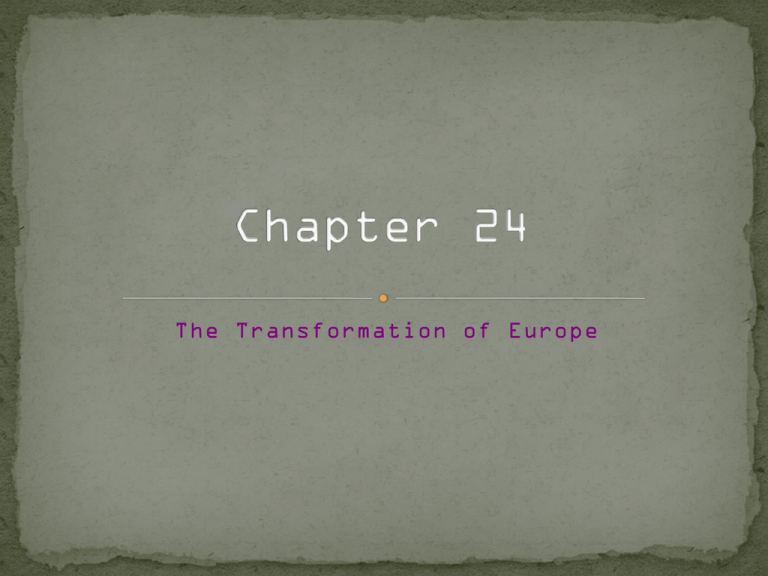
The Transformation of Europe R. H. Bainton The Reformation of the 16c Thus, the papacy emerged as something between an Italian city-state and European power, without forgetting at the same time the claim to be the vice-regent of Christ. The Pope often could not make up his mind whether he was the successor of Peter or of Caesar. Such vacillation had much to do with the rise and success of the Protestant Reformation. Martin Luther (1483-1546) attacks Roman Catholic church practices, 1517 Indulgences: preferential pardons for charitable donors Writes Ninety-Five Theses, rapidly reproduced with new printing technology Excommunicated by Pope Leo X in 1521 1520s-1530s dissent spread throughout Germany and Switzerland Luther’s expanded critique Closure of monasteries Translations of Bible into vernacular End of priestly authority, especially the Pope Return to biblical text for authority German princes interested Opportunities for assertion of local control Support for reform spreads throughout Germany Caricature of Pope Alexander VI by Martin Luther, 1545 The Spread of Lutheranism The Peasant Revolt - 1525 Switzerland, Low Countries follow Germany England: King Henry VIII (r. 1509-1547) has conflict with Pope over requested divorce England forms its own church by 1560 France: John Calvin (1509-1564) codifies Protestant teachings while in exile in Geneva Scotland, Netherlands, Hungary also experience reform movements A French priest and lawyer, who like Luther, believed that Christians could only reach heaven through faith in God. Unlike Luther, he promoted predestination, the belief that God had determined before the beginning of time who would achieve salvation. Wrote Institutes of the Christian Religion, codifying Protestant teachings. Reformation Europe (Late 16c) Roman Catholic church reacts Refining doctrine, missionary activities to Protestants, attempt to renew spiritual activity Council of Trent (1545-1563) periodic meetings to discuss reform Called by Pope Paul III, the goal was to end church abuses and set up schools to educate clergy Society of Jesus (Jesuits) founded by St. Ignatius Loyola (1491-1556) Rigorous religious and secular education Effective missionaries spread Christianity to Asia, Africa and the Americas Most prominent in regions of tension between Catholics and Protestants Late 15th century development in belief in Devil and human assistants 16th-17th centuries approximately 110,000 people put on trial, some 60,000 put to death Vast majority females, usually single, widowed Held accountable for crop failures, miscarriages, etc. New England: 234 witches tried, 36 hung Witches by Hans Baldung Grien, Woodcut, 1508 Punishments for witchcraft in 16th-century Germany. 1508. An image of suspected witches being hanged in England, published in 1655. Burning of three witches in Baden, Switzerland 1585 Divine Right: - According to this way of thinking, the king is an agent of God, and his authority to rule comes directly from God. Believe he ruled by divine right. Married Queen Mary I of England (“Bloody Mary”) Strong financial supporter of the Spanish Inquisition Persecuted Protestants, especially the Calvinists in the Netherlands Protestants and Roman Catholics fight in France (1562- 1598) 1588 Philip II of Spain attacks England to force return to Catholicism English destroy Spanish ships by sending flaming unmanned ships into the fleet Netherlands rebel against Spain, gain independence by 1610 Led a revolt against Phillip II, using guerilla warfare - sudden unexpected attacks carried out by an unofficial military group or groups that are trying to change the government by assaults on the military. Protestant Churches in France (Late 16c) Holy Roman emperor attempts to force Bohemians to return to Roman Catholic Church All of Europe becomes involved in conflict Principal battleground: Germany Political, economic issues involved Approximately one-third of German population destroyed 1618-1648 Loss of German Lives in 30 Years’ War Emperor Charles V (r. 1519-1556) attempts to revive Holy Roman Empire as strong center of Europe Through marriage, political alliances Ultimately fails Protestant Reformation provides cover for local princes to assert greater independence Foreign opposition from France, Ottoman Empire Unlike China, India, Ottoman Empire, Europe does not develop as single empire, rather individual states Charles V abdicates to monastery in Spain Europe in 1559 Charles I of the Hapsburg family, an old German family who ruled Austria for over 600 years was, inherited not only Spain, but all of the Holy Roman Empire (where he was Charles V), giving him more land than any other ruler since Charlemagne in 800. Charles V stepped down and divided his great empire in 1556. Charles’ son Phillip II (right) received Spain and all its possessions, while Charles V’s brother Ferdinand I became the Holy Roman Emperor. Economy: Inflation, High Taxes, Imbalance of Trade Actions of Charles V: Religious Wars Too Expensive Decline of The Spanish Empire Actions of Phillip II: Expensive Wars, Loss of Netherlands Colonial Piracy Italy well-developed as economic power through trade, manufacturing, finance Yet England, France, and Spain surge ahead in 16th century, innovative new tax revenues England: Henry VIII Fines and fees for royal services; confiscated monastic holdings France: Louis XI, Francis I New taxes on sales, salt trade Founded by Fernando and Isabel in 1478 Original task: search for secret Christian practitioners of Judaism or Islam, later search for Protestants Spread to Spanish holdings outside Iberian peninsula in western hemisphere Imprisonment, executions Intimidated nobles who might have considered Protestantism Archbishop of Toledo imprisoned 1559-1576 England and Netherlands develop institutions of popular representation England: constitutional monarchy Netherlands: republic English Civil War, 1642-1649 Begins with opposition to royal taxes Religious elements: Anglican church favors complex ritual, complex church hierarchy, opposed by Calvinist Puritans King Charles I and parliamentary armies clash King loses, is beheaded in 1649 Puritans take over, becomes a dictatorship Monarchy restored in 1660, fighting resumes Resolution with bloodless coup called Glorious Revolution King James II deposed, daughter Mary and husband William of Orange take throne Shared governance between crown and parliament King Philip II of Spain attempts to suppress Calvinists in Netherlands, 1566 Large-scale rebellion follows, by 1581 Netherlands declares independence Based on a representative parliamentary system By the late 1600’s, France had replaced Spain as the most powerful European nation. In 1589, a Huguenot leader and Bourbon prince (a royal family prominent in Europe) inherited the French throne as Henry IV. Knowing a Protestant would have trouble ruling a predominantly Catholic land, he became Catholic. “Paris is well worth a Mass” Theory of Divine Right of Kings French absolutism designed by Cardinal Richelieu (under King Louis XIII, 16241642) Destroyed castles of nobles, crushed aristocratic conspiracies Built bureaucracy to bolster royal power base Ruthlessly attacked Calvinists • Henry IV was murdered in 1610. His eight year old son, Louis XIII inherited the throne and chose Cardinal Richelieu to be his chief minister. • Richelieu subdued or defeated two groups that did not bow to royal authority: the nobles and the Protestant Huguenots. • He also created a strong bureaucracy by setting up intendants – regional representatives to the king. L’état, c’est moi: “The State – that’s me.” Magnificent palace at Versailles, 1670s, becomes his court Largest building in Europe 1,400 fountains 25,000 fully grown trees transplanted Power centered in court, important nobles pressured to maintain presence Inheriting the throne in 1643 as a five year old child, Louis XIV ruled France for 72 years. He further strengthened the monarchy and took the sun as the symbol of his power. During his reign, Louis: - Expanded the bureaucracy, appointing officials to collect taxes, recruit soldiers, and carry out his rule in the provinces. - Built the lavish, and expensive Palace of Versailles outside of Paris. - Organized a highly disciplined army, the strongest in Europe. - Persecuted the Protestant Huguenots, depriving the nation of many of its hardest working and prosperous citizens. Louis’s claim to absolute power was strengthened by a court preacher, Bishop Jacques Bossuet who argued that the king was entitled to unquestioning obedience. • In 1700, the last Spanish Hapsburg king (Carlos II) died and Louis ensured that his grandson Phillip V inherited the throne. • The surrounding allies, specifically England saw this as a threat to the balance of power and began the War of the Spanish Succession which carried on until 1713 when France agreed to sign the Treaty of Utrecht. • This stated that Phillip could remain on the throne, but that the Spanish crown and the French crown must remain separate and never unite. • The treaty also gave French lands in North America to England (in Newfoundland and Maine). The first Tudor king was Henry VII, who made England prosperous and stable. His son Henry VIII, established a new official church for England, the Anglican Church, or the Church of England, when the Roman Catholic Pope would not grant him the divorce he wanted. Henry VIII Mary I, the oldest daughter of Henry VIII, came to the throne in 1533 to become the first reigning queen of England. A devout Catholic, Mary tried to destroy the Anglican Church that her father had founded, but most of her subjects were Protestant and did not support her. By burning hundreds at the stake, she earned herself the nickname “Bloody Mary.”

